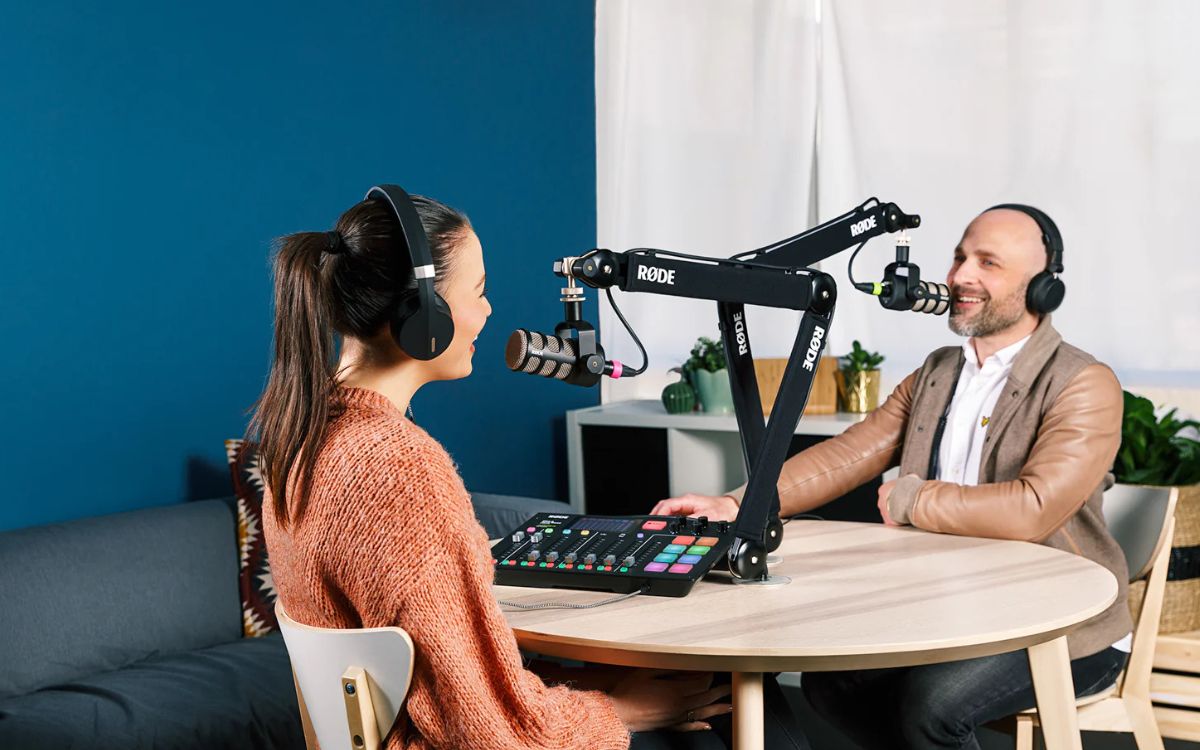Home>Events & Info>Podcast>How To Make A Successful Podcast


Podcast
How To Make A Successful Podcast
Modified: February 17, 2024
Learn the essential steps to create and launch a successful podcast. Gain valuable insights on podcasting strategies and tips for building an engaged audience.
(Many of the links in this article redirect to a specific reviewed product. Your purchase of these products through affiliate links helps to generate commission for AudioLover.com, at no extra cost. Learn more)
Table of Contents
Introduction
Welcome to the exciting world of podcasting! In recent years, podcasts have exploded in popularity, offering a unique platform for individuals, businesses, and organizations to share their knowledge, stories, and perspectives with a global audience. With millions of podcasts available on various topics, it can be daunting to stand out from the crowd and create a successful podcast that captures the attention of listeners.
In this article, we will explore the key components and strategies for making a successful podcast. From finding your podcast niche to promoting and monetizing your show, we will cover everything you need to know to get started on your podcasting journey.
So why should you consider starting a podcast? For starters, podcasts provide a convenient and accessible way for people to consume content on the go. Whether someone is commuting, exercising, or relaxing at home, they can tune into a podcast episode and gain valuable insights or be entertained.
Furthermore, podcasts offer a unique level of intimacy and connection with listeners. Hearing someone’s voice can create a more personal and engaging experience compared to reading or watching content. This allows you to develop a loyal and dedicated audience who genuinely connect with your message.
Another advantage of podcasting is the ability to reach a global audience. With platforms such as Apple Podcasts, Spotify, and Google Podcasts, your show can be accessed by millions of people around the world. This opens up endless opportunities for collaboration, networking, and building a community around your podcast.
However, it’s important to note that creating a successful podcast requires careful planning, quality content, and effective promotion. With so many podcasts to choose from, you need to find your unique voice and offer something valuable and appealing to your target audience.
Throughout this article, we will guide you through the necessary steps to make your podcast stand out. From finding your podcast niche to creating captivating content, promoting your show, and monetizing your efforts, we’ve got you covered.
So, let’s dive in and learn how to make a podcast that captivates, educates, and entertains!
Finding Your Podcast Niche
One of the first and most crucial steps in creating a successful podcast is to find your niche. A podcast niche refers to a specific topic or theme that your podcast will revolve around. Choosing the right niche is essential because it helps you establish a clear target audience and differentiate your show from the vast array of existing podcasts.
When considering your podcast niche, it’s important to think about your passions, expertise, and what topics resonate with you. You want to choose a niche that you are genuinely interested in and can provide valuable insights or entertainment to your listeners.
Here are some strategies to help you find your perfect podcast niche:
- Identify your expertise: Consider your professional background, hobbies, or areas of knowledge that you can leverage to create compelling content. Think about what topics you can confidently speak about and offer unique insights or perspectives. This will help you establish yourself as an authority in your niche and attract listeners who are interested in your expertise.
- Follow your passion: Choose a topic that you are truly passionate about. When you’re passionate about a subject, it shines through in your episodes, making them more engaging and authentic. Plus, your enthusiasm will help you stay motivated and committed to consistently producing high-quality content.
- Research existing podcasts: Explore the podcast landscape and identify popular topics that resonate with audiences. Look for gaps or underserved niches that you can fill with your unique spin or perspective. Don’t be afraid to put your own twist on a popular topic to make it stand out.
- Consider your target audience: Think about the audience you want to attract with your podcast. Consider their demographics, interests, and pain points. Tailoring your content to a specific audience will help you create focused and relevant episodes that resonate with your listeners.
- Validate your niche: Once you have a few potential podcast niches in mind, do some market research to validate their viability. Look for keywords related to your niche using tools like Google Trends or keyword research tools. This will give you an idea of the search volume and competition for your chosen topic.
Finding your podcast niche may require some experimentation and refining along the way. Remember, it’s okay to evolve and adapt your niche as you gain more insights about your audience and what resonates with them.
By choosing a specific and focused podcast niche, you can position yourself as an expert, attract a dedicated audience, and differentiate your show from the vast podcast landscape.
Planning Your Podcast Format
Now that you have identified your podcast niche, it’s time to plan the format of your show. The podcast format refers to how you structure and present your content to your audience. Having a well-defined format is essential as it sets the tone, style, and structure of your episodes.
Here are some key considerations for planning your podcast format:
- Determine episode length: Decide on the ideal length for your episodes. Consider the type of content you will be discussing and the preferences of your target audience. Some podcasts are short and snappy, around 15-20 minutes, while others may run for an hour or more. Find a balance that keeps your audience engaged without overwhelming them.
- Select a hosting style: Choose how you will present your podcast content. This can include solo hosting, co-hosting with someone else, or featuring guest interviews. Each hosting style offers a different dynamic and allows for different types of conversations and perspectives. Consider what style aligns best with your niche and audience.
- Create segments: Consider incorporating segments into your episodes to add variety and structure. Segments can include listener Q&A, expert tips, or even storytelling elements. Segments help break up the content and keep your audience engaged throughout the episode.
- Create an episode outline: Before recording, create a detailed outline for each episode. This outline will serve as your roadmap and ensure that you cover all the key points and stay organized during recording. It can include the main topics, subtopics, key questions, and any important points you want to discuss.
- Add music and sound effects: Consider incorporating music or sound effects into your episodes to enhance the listening experience. Intro and outro music can help set the tone of your show, while sound effects can add impact or emphasize certain points. However, be sure to use royalty-free music and sound effects to avoid copyright issues.
- Create a consistent release schedule: Decide on a regular release schedule for your episodes. Consistency is key in podcasting as it helps you build a loyal audience and sets expectations. Whether you release episodes weekly, bi-weekly, or monthly, stick to your schedule and communicate it to your listeners.
- Consider transcription or show notes: Offering transcription or show notes for your episodes can provide additional value to your audience. Transcripts make your content more accessible to different types of learners, while show notes provide a summary and overview of the episode. This can also boost your SEO efforts as it provides written content for search engines to crawl.
Remember, the podcast format you choose should align with your niche and resonate with your target audience. It should keep them engaged, provide value, and reflect your unique style and personality.
By planning your podcast format in advance, you can create a cohesive and enjoyable listening experience for your audience while maintaining an organized and efficient production process.
Setting up Recording Equipment
When it comes to podcasting, having the right recording equipment is essential for producing high-quality audio. While there are various equipment options available, here are the key components you’ll need to set up your recording studio:
- Microphone: Invest in a good-quality microphone to ensure clear and professional-sounding audio. USB microphones, such as the Blue Yeti or Audio-Technica ATR2100x, are popular choices for beginners as they are user-friendly and plug directly into your computer. XLR microphones, such as the Shure SM58 or Rode Procaster, offer even better sound quality, but require an audio interface to connect to your computer.
- Headphones: Use closed-back headphones to monitor your audio while recording. This helps you catch any audio issues, background noise, or distortions and make adjustments as necessary. Look for headphones with good sound isolation to minimize any external noises that may interfere with your recording.
- Pop Filter: A pop filter is a screen placed in front of your microphone to prevent plosive sounds (such as “p” or “b” sounds) from distorting your audio. It helps achieve cleaner and clearer sound quality. You can easily attach a pop filter to the microphone stand or use a microphone that comes with an integrated pop filter.
- Boom Arm or Microphone Stand: A boom arm or microphone stand is used to position your microphone at the desired height and distance from your mouth. This helps maintain consistent audio quality and minimizes handling noise. Look for options that are sturdy, adjustable, and easy to use.
- Acoustic Treatment: Consider adding some acoustic treatment to your recording space to minimize echo and improve sound quality. This can include foam panels, bass traps, or diffusers placed strategically on the walls, floor, or ceiling to absorb or scatter sound waves. If you’re on a budget, even using blankets or foam insulation can make a noticeable difference.
- Audio Interface: If you decide to use an XLR microphone, you will need an audio interface to connect it to your computer. The audio interface acts as a bridge between your microphone and your computer, converting analog audio signals into digital signals. Popular audio interfaces include the Focusrite Scarlett series or the PreSonus AudioBox USB.
- Recording Software: Choose a recording software to capture your audio. There are many options available, from free software like Audacity to professional tools like Adobe Audition or GarageBand. Select software that suits your needs, offers good audio editing capabilities, and is compatible with your computer.
Once you have your equipment set up, it’s important to do a few test recordings and adjust the microphone placement and settings to achieve optimal sound quality. Experiment with different microphone distances, gain levels, and room setups to find the best sound that suits your voice and recording environment.
Remember, while having good recording equipment is important for producing high-quality audio, content and delivery are equally crucial. Focus on providing valuable and engaging content to your audience while maintaining a clear and professional audio presence.
With the right recording equipment and a little practice, you’ll be well on your way to creating a podcast that captivates your listeners.
Editing Your Podcast
Once you have recorded your podcast episode, the next step is to edit it. Editing plays a crucial role in refining the audio, removing any mistakes or distractions, and creating a polished final product. Here are some key steps and tips for editing your podcast:
- Organize your files: Create a dedicated folder on your computer to keep all your podcast files organized. This includes your raw audio files, intro/outro music, sound effects, and any other assets you plan to use in your episodes.
- Import audio files: Open your chosen recording software and import your recorded audio files into the project. Most editing software allows you to drag and drop the files directly into the interface.
- Remove background noise: Clean up your audio by removing any background noise or unwanted sounds. Use the noise reduction tool in your editing software to minimize ambient noise and improve the overall clarity of your recording.
- Trim and adjust audio: Trim any unnecessary silences, pauses, or mistakes throughout the episode. Ensure a smooth flow by tightening up the timing between segments or removing any awkward transitions. Adjust the volume levels to maintain consistent audio quality throughout.
- Edit out mistakes: Edit out any mistakes, stumbles, or errors you may have made during recording. Cut out any portions that detract from the overall quality of the episode or disrupt the listener’s experience.
- Add music and sound effects: Consider adding background music, intro/outro music, or sound effects to enhance the listening experience. Use royalty-free music and sound effects that complement the tone and theme of your podcast. Be mindful not to overpower the dialogue with too much music or sound effects.
- Enhance audio quality: Use audio effects such as EQ, compression, and normalization to enhance the overall audio quality. EQ can help balance the frequencies and remove any harshness or muddiness, while compression can help even out volume levels. Normalization ensures that the audio reaches a consistent level without clipping or distortion.
- Review and fine-tune: Listen to the entire edited episode from start to finish to ensure a seamless listening experience. Pay attention to timing, transitions, and overall coherence. Make any necessary adjustments or tweaks to perfect the episode.
- Export the final file: Once you are satisfied with the edits, export the final audio file in the desired format. Consider using MP3 format with a bit rate of 128kbps or higher for optimal podcast audio quality.
Don’t forget to save a copy of the edited episode and back up your files to ensure you don’t lose any valuable work.
While editing your podcast may seem daunting at first, with practice and patience, you will become more proficient and efficient in the process. Remember to strike a balance between removing flaws and maintaining a natural and authentic flow in your podcast episodes.
By investing time and effort into editing, you can create a polished and professional podcast that keeps your audience engaged and coming back for more.
Creating Captivating Podcast Intro and Outro
The intro and outro of your podcast are crucial elements that set the tone, create a lasting impression, and engage your listeners right from the start. A captivating intro and outro can grab attention, build anticipation, and leave a memorable impact. Here are some tips for creating compelling podcast intros and outros:
- Craft a hook: Start your podcast intro with a captivating hook that grabs the listener’s attention and entices them to continue listening. This can be a thought-provoking question, a compelling statement, or a powerful anecdote that relates to the content of your episode.
- Introduce your podcast: Clearly state the name of your podcast and provide a brief description of what it is about. This helps new listeners understand what they can expect from your show and establishes the context for the episode.
- Set the tone: Use the intro to set the tone and mood of your podcast. Think about the emotions or atmosphere you want to convey. Whether it’s uplifting, informative, inspirational, or humorous, align the tone with your podcast’s overall theme and branding.
- Showcase your personality: Let your personality shine through in the intro. Inject your unique style, enthusiasm, or humor to create a connection with your listeners. This helps establish rapport and makes your podcast more relatable and engaging.
- Highlight episode content: In the intro, briefly mention the key topics or highlights that you will be discussing in the episode. This gives your audience a glimpse of what’s to come and provides a compelling reason to keep listening.
- Incorporate music: Use music to enhance the energy and impact of your intro and outro. Choose a catchy and memorable tune that aligns with the vibe of your podcast. Consider using royalty-free music or custom compositions to avoid copyright issues.
- Include call-to-action: In the outro, include a call-to-action to encourage your listeners to take a specific action. This could be subscribing to your podcast, leaving a review, following you on social media, or visiting your website. Make it clear, concise, and appealing.
- Express gratitude: Take a moment in the outro to express your gratitude to your listeners for tuning in and supporting your podcast. Show appreciation for their time and support, which helps foster a sense of community and loyalty.
- Keep it concise: Aim to keep both the intro and outro relatively brief. Ideally, they should be around 30 seconds to a minute in length, ensuring that they don’t overshadow the main content of your episodes.
- Review and refine: Listen to your podcast intros and outros with a critical ear. Consider seeking feedback from trusted listeners or fellow podcasters to gather insights and make improvements. Continuously refine and evolve your intros and outros to maintain freshness and engage your audience.
Remember, your podcast intros and outros have the power to leave a lasting impression on your listeners. By carefully crafting them with attention-grabbing hooks, highlighting your unique personality, and setting the right tone, you can create a captivating podcast experience that keeps your audience coming back for more.
Writing Engaging Podcast Script
An engaging podcast script is the foundation for creating compelling episodes that captivate your audience. While some podcasts may be more conversational and unscripted, having a well-prepared script can help you stay focused, deliver your content effectively, and ensure a seamless flow. Here are some tips for writing an engaging podcast script:
- Outline your main points: Start by outlining the main topics or points you want to cover in your episode. This provides a roadmap for your script and helps you stay organized as you develop your content.
- Consider your target audience: Keep your target audience in mind as you write your script. Consider their interests, needs, and preferences. Tailor your content to provide value and cater to their expectations.
- Inject storytelling elements: Stories have a powerful impact on listeners. Incorporate storytelling elements into your script to make your content more relatable and engaging. Share personal anecdotes, case studies, or examples to illustrate your points and connect with your audience.
- Keep it conversational: Write your script in a conversational tone. Imagine you’re having a conversation with a friend or a listener. Avoid using overly formal or technical language that can alienate your audience. Be approachable, relatable, and authentic in your delivery.
- Use engaging openings: Start each segment or topic with a strong and engaging opening. Use attention-grabbing hooks, thought-provoking questions, or intriguing statements to draw your listeners in and entice them to continue listening.
- Include transitions: Smooth transitions between segments or topics keep your episode flowing seamlessly. Use transition phrases or segues to guide your listeners from one point to another. This helps maintain engagement and clarity throughout your episode.
- Balance information and entertainment: Find the right balance between providing valuable information and keeping your audience entertained. Engage your listeners by using anecdotes, humor, or interesting facts to make your content more engaging and enjoyable.
- Use subheadings or bullet points: Break down your script into subheadings or bullet points for better organization and readability. This helps you stay on track during recording and makes it easier for your listeners to follow along.
- Include calls-to-action: Incorporate calls-to-action throughout your script to encourage listener interaction. This could be inviting them to leave a review, join a community, or participate in a discussion related to your episode. Make your calls-to-action clear, concise, and compelling.
- Practice and refine: Read through your script multiple times and practice delivering it out loud. Refine your script by removing any unnecessary repetitions, clarifying complex ideas, or restructuring sentences for better flow and clarity. Practice helps you sound more natural and confident during recording.
Remember, a well-crafted podcast script serves as a guide, not a strict script to adhere to. Allow room for spontaneity, natural conversation, and listener engagement as you record your episodes. Use your script as a foundation to ensure you cover all the key points while allowing your personality and unique style to shine through.
By writing an engaging podcast script, you can deliver valuable, informative, and entertaining content that keeps your audience hooked from start to finish.
Promoting Your Podcast
Creating a fantastic podcast is just the first step. To reach a wider audience and grow your listener base, you need to effectively promote your podcast. Here are some key strategies and tips for promoting your podcast:
- Create a compelling podcast trailer: A podcast trailer is a brief preview of your show that captures the essence of what listeners can expect. It serves as a powerful promotional tool to generate interest and attract new listeners. Make sure your trailer is engaging, highlights your unique selling points, and leaves people wanting more.
- Optimize your podcast for SEO: Use relevant keywords in your podcast title, description, and episode titles to improve your discoverability in search engines and podcast directories. This allows potential listeners to find your podcast when searching for related topics.
- Utilize social media platforms: Leverage the power of social media to promote your podcast. Create dedicated accounts for your podcast on platforms like Facebook, Instagram, Twitter, and LinkedIn. Regularly share engaging content, teasers, behind-the-scenes snapshots, and updates to attract and engage your audience. Interact with your listeners by responding to comments, questions, and feedback.
- Collaborate with other podcasters: Identify podcasters in your niche or related areas and explore opportunities for collaboration. This can include guest appearances on each other’s shows, cross-promotion, or participating in roundup episodes. Collaborations can help you tap into new audiences and expand your reach.
- Guest on other podcasts: Seek opportunities to be a guest on other podcasts with similar audiences. Sharing your expertise and insights on other shows can introduce you to new listeners who may be interested in your content. Be sure to mention your podcast and provide links in the episode or show notes.
- Utilize podcast directories: Submit your podcast to popular podcast directories like Apple Podcasts, Spotify, Google Podcasts, and Stitcher. Ensure your podcast details, including title, description, and artwork, are optimized and captivating to attract potential listeners browsing through these directories.
- Engage with your audience: Foster a sense of community by actively engaging with your existing listeners. Respond to comments, reviews, and messages to show your appreciation and build connection. Encourage listeners to leave reviews, as positive reviews can help attract new listeners and improve your podcast’s ranking in directories.
- Create shareable content: Develop shareable content related to your podcast that can be easily shared on social media, such as audiograms, quote images, or teaser clips. Encourage your audience to share these snippets with their networks, extending your reach organically.
- Utilize your network: Tap into your personal and professional network to spread the word about your podcast. Share it with friends, family, colleagues, and acquaintances who might be interested. Word-of-mouth referrals can be powerful in attracting new listeners.
- Consider paid advertising: If you have a budget for promotion, explore paid advertising options such as social media ads, podcast-specific ad networks, or sponsorships. Target your ads to reach audiences who are likely to be interested in your podcast.
Remember, consistent and strategic promotion is key to growing your podcast audience. Experiment with different strategies, track your results, and refine your promotional efforts based on the feedback and insights you gather.
By effectively promoting your podcast, you can increase your visibility, attract new listeners, and build a loyal community around your show.
Building an Audience
Building an audience for your podcast is an ongoing process that requires dedication, consistency, and effective engagement strategies. Here are some key steps to help you build an audience for your podcast:
- Create valuable and engaging content: Your content is the foundation for building an audience. Focus on providing valuable information, interesting stories, and engaging discussions that resonate with your target audience. Consistency is key, so aim for regular episodes to keep your audience engaged and coming back for more.
- Know your target audience: Understand who your target audience is and what they are looking for in a podcast. This knowledge will help you tailor your content, tone, and style to meet their preferences. Conduct research, engage with your listeners, and analyze feedback to gain valuable insights.
- Engage with your audience: Actively engage with your audience to create a sense of community and connection. Respond to comments, questions, and feedback both on your podcast platform and on social media. Encourage listener participation through interactive elements such as Q&A segments, listener shoutouts, or contests.
- Promote your podcast consistently: Implement consistent promotion strategies to attract new listeners. Utilize social media platforms, collaborate with other podcasters, network within your niche, and actively seek opportunities to guest on other podcasts. Leverage your existing network and encourage word-of-mouth referrals from satisfied listeners.
- Optimize your podcast for search: Apply SEO techniques to make your podcast more discoverable. Use relevant keywords in your title, episode descriptions, and show notes to improve your search engine rankings. Consider utilizing transcriptions or show notes to provide written content that search engines can crawl.
- Encourage reviews and ratings: Positive reviews and ratings can be instrumental in building credibility and attracting new listeners. Encourage your audience to leave reviews on podcast directories and platforms like Apple Podcasts. Engage with your listeners and express gratitude for their support, which can foster a loyal and supportive audience.
- Cross-promote with other platforms: Leverage your existing online presence, such as a blog, YouTube channel, or email newsletter, to promote your podcast. Cross-promote your podcast on these platforms to reach new audiences who may already be interested in your content. Include links or embed podcast episodes in your blog posts or newsletters.
- Offer valuable incentives: Provide additional value to your audience by offering exclusive content, bonus episodes, or access to a community or membership area. This can incentivize listeners to engage further, become loyal supporters, and refer your podcast to others.
- Attend podcasting events and conferences: Network with fellow podcasters, potential guests, and industry professionals by attending podcasting events and conferences. Make meaningful connections, share knowledge, and explore collaborative opportunities that can help expand your audience reach.
- Continuously analyze and refine: Regularly analyze your podcast metrics, such as download numbers, listener demographics, and episode performance. Utilize this data to identify trends, understand your audience better, and make informed decisions on how to improve your content, engagement strategies, and promotional efforts.
Building an audience takes time and dedication, but with consistent effort and a commitment to delivering valuable content, you can attract and retain a loyal and engaged listenership. Keep refining your strategies, act on feedback from your audience, and adapt to evolving trends to continue growing your podcast.
Monetizing Your Podcast
Monetizing your podcast is an exciting prospect that allows you to turn your passion into a profitable venture. While it may take time and effort to establish a solid monetization strategy, there are several avenues you can explore to generate revenue from your podcast. Here are some popular methods for monetizing your podcast:
- Sponsorships and advertising: Partnering with relevant brands and advertisers can be a lucrative way to monetize your podcast. As your listenership grows, you can approach companies in your niche and offer sponsorship opportunities. Be sure to promote products or services that align with your audience’s interests and provide value.
- Affiliate marketing: Joining affiliate programs allows you to earn commissions by promoting products or services on your podcast. Include unique affiliate links or discount codes in your episodes or show notes, and earn a percentage of sales made through those links.
- Creating premium content: Offer exclusive premium content to your dedicated listeners. This can include bonus episodes, behind-the-scenes access, or additional resources. Set up a membership or subscription model where listeners pay a fee to access this exclusive content.
- Crowdfunding: Platforms like Patreon or Ko-fi allow your audience to support your podcast financially through one-time donations or recurring contributions. Offer unique perks or rewards to your supporters, such as early access to episodes, merchandise, or personalized shoutouts.
- Merchandise sales: Create and sell podcast-related merchandise, such as t-shirts, mugs, or stickers. Promote your merchandise on your podcast and through your online platforms. This not only generates revenue but also helps to build brand recognition.
- Live events and workshops: Organize live events, workshops, or webinars related to your podcast’s topic. Charge admission or registration fees for attendees to participate in these events. This can provide an opportunity to connect with your audience in person and generate income.
- Public speaking and consulting: Establish yourself as an expert in your podcast’s niche and offer your services as a speaker or consultant. Participate in industry conferences, give presentations, or provide one-on-one consulting services to individuals or businesses interested in your expertise.
- Podcast network affiliation: Joining a podcast network can provide opportunities for monetization. These networks often facilitate sponsorships, cross-promotion, and advertising deals on behalf of their member podcasts.
- Marketplace platforms: Platforms like Patreon, Spotify’s Anchor, or Himalaya offer monetization features that allow listeners to make donations or subscribe for exclusive content directly through the platform.
- Direct sponsorships: Reach out to businesses or individuals directly to offer sponsorship opportunities. This allows you to negotiate custom deals and establish a direct relationship with your sponsors, giving you more control over the terms and revenue generated.
It’s essential to strike a balance between monetization and maintaining the quality and integrity of your podcast. Consider your audience’s needs and preferences when exploring monetization methods, and always prioritize providing value to your listeners. Be transparent with your audience about your monetization efforts and ensure that any sponsored content is clearly disclosed.
Remember, building a sustainable revenue stream from your podcast takes time, consistency, and innovation. As you grow your audience and refine your monetization strategies, you can turn your podcast into a viable and rewarding source of income.
Conclusion
Creating a successful podcast requires a combination of passion, dedication, and strategic efforts. By following the steps outlined in this guide, you can launch a podcast that captivates, educates, and entertains your audience.
We started by emphasizing the importance of finding your podcast niche. Choosing a focused and unique topic allows you to establish yourself as an authority and attract a dedicated audience. From there, we discussed planning your podcast format, setting up recording equipment, and editing your episodes to ensure high-quality audio production.
Additionally, we covered the essential elements of creating captivating podcast intros and outros and writing engaging podcast scripts. These elements set the tone, hook listeners, and keep them engaged throughout your episodes.
But creating a successful podcast doesn’t end with producing great content. We highlighted the significance of promoting your podcast through social media, collaborations, directory listings, and strategic networking. Building an audience requires consistent effort, engagement, and a deep understanding of your target audience.
Furthermore, we explored different methods of monetizing your podcast, such as sponsorships, advertising, affiliate marketing, and merchandise sales. These strategies can help you turn your passion into a profitable venture while maintaining the trust and loyalty of your listeners.
In conclusion, creating a successful podcast is a multi-faceted process that requires careful planning, consistent effort, and a deep understanding of your audience. By finding your niche, delivering valuable content, engaging with your listeners, and exploring various monetization avenues, you can build a thriving podcast that resonates with your target audience and provides a rewarding experience for all involved.
So, go ahead and take the leap into the world of podcasting. Your unique voice and perspective have the power to inspire, educate, and entertain countless listeners around the globe. Start planning, start recording, and start sharing your story with the world. Happy podcasting!











